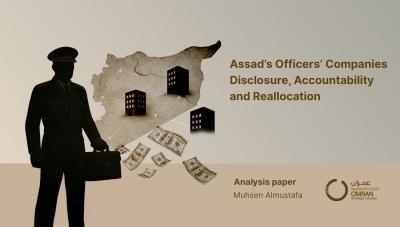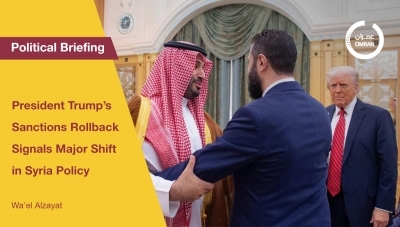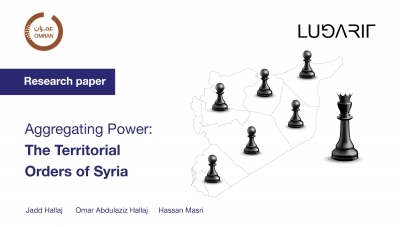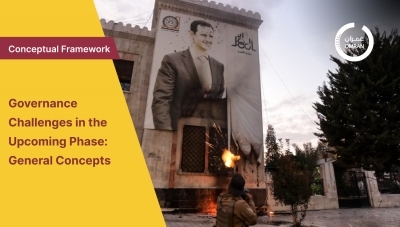Media Appearance
Transformations of the Syrian Military: The Challenge of Change and Restructuring
Executive Summary
- Throughout its history, the Syrian military has gone through a number of stages in its structural and functional evolution. These include processes undertaken based on the need to develop the military’s professional and technical capacity, or as required for the domination and control of the regime over the army, or as dictated by the war conditions. But since Hafez al-Assad took power, the military has become a major actor in local “conflicts,” whether as a result of the social composition of the military and the sectarian engineering efforts started by Hafez al-Assad and continued by Bashar al-Assad, the special privileges granted to military members, or as a result of the military doctrine that is customized for the preservation of the regime and not based on national ideals. Some of the most significant structural and human changes in the history of the Syrian military took place between 2011 and 2018. These shifts included the entry of auxiliary non-Syrian forces, both individuals and groups, which completely changed the role of the “army” from that of a traditional national army into a force used primarily to protect the ruling regime.
- As a result of the unexpected outbreak of military operations across the country against a popular uprising, there was a significant increase in the number of amendments made to laws governing the military establishment in order to address gaps in those laws. Some of the laws were ignored in favor of custom and tradition. This was reflected in the promotion and evaluation of officers based on sectarian or regional affiliations. The introduction of a partial mobilization in Syria without official certification of the decision as a result of the events starting in 2011, and the issuance of a new mobilization law at the end of 2011, supported the regime's efforts to distribute mobilization tasks to all state institutions and departments. Previously, the last law on mobilization had been issued in 2004.
- At the outset of the uprising in Syria, the military's deployments were characterized by complete chaos. The regime's use of local and foreign militias, in addition to the Iranian and Russian regimes, transformed this deployment from complete chaos to a more organized chaos. The regime was able to recapture many villages and cities based on a strategy of collective punishment, scorched earth offensives, and guerrilla warfare. The Syrian regime's use of local and foreign militias led to an imbalance in the structure and responsibilities of the army during the revolution, so that the military became a more Alawite-dominated institution because of its reliance on its Alawite members. Most of the officers were corrupt, and that corruption became much worse during the years of revolution, causing the military to become increasingly distant and isolated from society. This pushed the officers to collude with corrupt networks within the regime and to exploit them to achieve further gains and accumulate wealth.
- In 2018, the military landscape witnessed many major transformations, most notably the division of the country into three main international spheres of influence, each of which contained a diverse mix of local political powers. In the first sphere controlled by the regime, there were indicators of increased Iranian and Russian influence, as well as an attempt to consolidate the militia scene, with some being dissolved and others linked to Iran being integrated and merged with others. In the second sphere: includes the armed opposition forces in northern Syria backed by Ankara, the map of relevant armed actors became more disciplined and contained under the framework of the Astana talks. Opposition forces displaced from southern and central Syria were restructured by Ankara in support of the Euphrates Shield and Olive Branch operations. In the third sphere: the Syrian Democratic Forces (SDF) continued to perform their security and military functions under the self-administration project and its legal framework. At the same time, their negotiations with the Assad regime continued, leaving their options wide open and making it more likely that the situation would get more complicated because of the lack of a clear policy from the Americans who supported the SDF on the one hand and pushed for further negotiations on the other.
- The regime’s attempts to reduce and contain the roles carried out by Iranian and local militias were not comprehensive or well organized. On one hand, many Iran-backed militias became integrated into the official regime military structure following the formalization of Iranian operations in Syria, which did not reduce or contain its power or impact. On the other hand, the overall reintegration strategy was not adhered to especially with regards to local militias or groups that settled through reconciliation agreements, as the objective of conducting operations against opposition forces is still prevalent and dominating deployments. This process of reintegration will face further obstacles that will greatly hinder any restructuring process as a result of the deep infiltration of such militias and the diverse roles they play in society and within the security sector.
- The data and indicators examined by the papers contained in this book highlight the deep and significant impact of transformations in the military institution both in the medium and long terms. These transformations are observed in the structural and functional imbalances of the military institution especially as it faces a deficit of power, capacity, and resources. Furthermore, the regime’s military institution has become one of many other actors in the scene and often held hostage to local and international networks of power, whether it is the Russian or Iranian or other local groups. It is also restricted in its capacity because its imbalanced societal composition, has not adopted political neutrality, and the ideological party doctrine that dominates. All this necessitates a rebuilding strategy that is absent from the current regime’s agenda as well as its allies in favor for superficial rehabilitation for the purpose of regaining control of territory and society.
- In the face of the current frame of reference that guide the reform course of the military institution, the absence of a national agenda or vision should be noted. This vision should stipulate the requirements for the reform process, most important of which is the political process and change, depoliticizing the military institution, protecting political life from military interferences, and the reinforcement of healthy and normal civil-military relations that enhance its performance.
Introduction
Based upon the need to redefine the roles of the Syrian military institution in light of the profound transformations in the concept of nation-state, Omran Center for Strategic Studies launched this research project to further analyze those transformation and address the challenge of change and restructuring. The approach first deconstructs and assesses the functions and structures of the Syrian army, its doctrine, and causes behind its involvement and interference in social and political affairs in accordance with the regime’s philosophical vision of domination and totalitarian control. The papers contributed by researchers in the first phase of this project are as follows:
- The Syrian Army 2011-2018: Roles and Functions
- Military Actors and Structures in Syria in 2018
- Stability and Change: The Future of the Military in Syria
- Annex Report 1: Significant Transformations in the Army: 1945-2011
- Annex Report 2: Laws and Regulations Governing the Military After 2011.
The outputs of papers and reports in this book assess indicators of instability in the map of military actors and measure its impact on the centrality of defense and security functions and the future end game for the nodes of power within the military after possible reintegration processes. It also focuses on the relationship between the military and political spheres, in the sense that it evaluates the potential for military actors to contribute to various avenues of reform, including the redistribution of power in a legally decentralized manner. Similarly, it also looks at the changing political situation and the positions taken by regional and international backers of armed groups, which influence the decisions of military actors, leaving them with limited options.
This book first outlines the main historical developments in the Syrian military in order to establish a more comprehensive understanding of the shortfalls in the military structures and how they developed. It also looks at the most important laws and amendments related to the military establishment and how they have evolved over time. The book also describes how the military leadership used these laws after the start of the Syrian revolution to recruit fighters to the military that were completely loyal to the ruling regime.
The papers and reports in this book try to answer a number of key questions such as: does the military in its current state embody features of effectiveness, adopt a national outlook, have the capacity and ability required to preserve and promote the outputs of a political process, and able to create and promote conditions for stability? Addressing these questions necessitated first to recognize the positioning of reform policies within the current and future military institution agenda, and to assess the presence or lack of a cohesive and stable structure after the profound transformations it witnessed. Finally, the book outlines an initial vision for a framework for reform that would allow this institution to be a catalyst for societal cohesion and adopt a politically neutral position to become a source of stabilization is Syria.
Omran Center plans to launch a second phase with additional papers to be based on the outcomes of papers contained in this book as well as discussion and feedback received from participants in the workshop held in Istanbul on October 25th, 2018 to focus potentially on the following topics:
- Sectarianization mechanisms in the Syrian military.
- Power nodes and networks in the Syrian military.
- Management of surplus manpower: a case study of the 4th and 5th corps.
- The military judicial system.
- Non-technical challenges in the reform of the military establishment.
For More Click here




